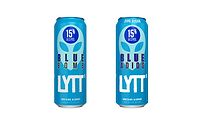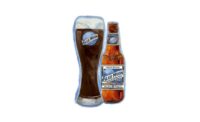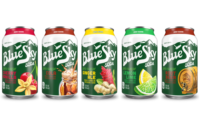
Family-owned for more than 70 years, the Callaway family started Callaway Blue Spring Water in 2001 to share the product of the family’s privately owned spring in Hamilton, Ga. Callaway Blue bottled water takes its name from its source, Blue Spring, a natural quartzite spring with an inherent vibrant blue color, the company says. Blue Spring is naturally preserved on the Callaway family’s private land and is surrounded by native azaleas, ferns and trees.
“As a matter of good fortune, we have a source with a story and it’s not one that’s hyped,” says Ken Callaway, executive vice president of the company. “We think the health-conscious consumer will want to know their water is coming from a source that is uncontaminated and one that is not likely to be compromised.”
Callaway Blue’s spring has a storied history that the company emphasizes in its marketing. Prior to the Callaway family’s ownership, the spring was owned by a New York-based businessman, who intended to join the spring with another nearby water source to supply water to Columbus, Ga., located about 25 miles south of Hamilton. The Great Depression impacted the business venture, so he offered the land for sale.
In 1930, Cason Callaway Sr. purchased the 1,000-acre watershed surrounding the quartzite aquifer that supplies Blue Spring. In 1937, President Franklin Roosevelt commissioned studies of native springs in the area, including Blue Spring. The research found that the vein of quartzite rock that encloses Blue Spring originates in Hollis, Ala., and runs about 100 miles through the spring beds in the area.
Naturally pure
Blue Spring is located at the base of Pine Mountain and its visible surface spring pool measures 30 feet across with an initial depth of 30 feet. The entire depth of the Blue Spring is unknown as the spring pool connects to a cave system that has been measured at 300 feet, but the spring’s lower passageways reach unknown depths because they are inaccessible to divers.
Callaway Blue taps the spring’s flow at a depth of 100 feet through fractured quartzite. The spring has a flow rate as high as 500 gallons a minute, the company says. The water flows by its own pressure and gravity 1,200 feet across the street where it is pumped to Callaway Blue’s bottling plant. Before arriving at Callaway Blue’s bottling facility, the spring water is naturally filtered and purified by the Hollis quartzite rock through which it flows.
Callaway Blue’s water has a pH of 6.7 and naturally contains calcium, magnesium, potassium, sodium and zinc, the company says. The spring water has been measured at 31 mg. a liter of total dissolved solids (TDS), which is the industry’s term to describe the inorganic salts and organic matter present in water, according to the World Health Organization. The organization reports that TDS content of less than 300 mg. in a liter is considered excellent quality and the amount of TDS can range up to 900 mg. a liter for water of fair condition.
Callaway Blue offers its water in 5- and 3-gallon bottles for office and home delivery, 1-gallon bottles, 750-ml. glass bottles for upscale restaurants, a variety of PET sizes and for private label branding. Callaway Blue is distributed in Georgia, Alabama, Florida, Tennessee, and North and South Carolina, says Lee Wall, vice president of sales for the company.
“The quality is not just in the water,” Wall says. “It’s Callaway Blue following proper bottling practices from filtration to final product.”
Although Callaway Blue’s water is not exposed to surface air or light until the water reaches the plant, it is purified at the plant using multiple micron-filtration and then is ozonated to ensure purification, the company says. The ozonation ensures purification of the water as well as its bottle and cap, Wall says.
The company maintains a filling line for 5- and 3-gallon bottles for home and office delivery. The bulk water is a staple in the area and helped Callaway Blue establish its reputation, Wall says. Callaway Blue delivers between 8,000 and 13,000 5- and 3-gallon bottles a week in its distribution area, he says.
The company’s bottling facility also has a bottling line for single-serve bottles that runs at speeds up to 360 bottles a minute. The company has the capacity to run 8-, 10-, 12- and 20-ounce PET bottles as well as half-liter and 1-liter packaging. For its branded and private label business, the company partnered with a local packaging company that supplies pre-labeled plastic bottles. Callaway Blue also has the ability to apply labels in-house for smaller orders.
“We’re proud of what we have,” Wall says. “I look at where we came from and where we are today, and it’s hard to think of Callaway Blue as that same small company because we’ve grown so much.”
Callaway Blue is committed to growth within its home region.
“Our goal is to be the premium brand of spring water in the Southeast,” he says. “We want to be recognized from a purity and quality standpoint and for our dedication to the history of conservation and preservation of the spring that the family has been dedicated to for 70 years.”
Conservation practices
Callaway Blue spring water is available in blue glass and plastic bottles that link to the spring’s inherent color. To promote environmental stewardship, the company promotes recycling initiatives for consumers and is dedicated to the tradition of preservation established by the Callaway family.
“We’re taking the story forward and creating a business that is focused on being good stewards of the environment,” Callaway says. “We’re looking for an honest advantage; we’re not trying to be as green as possible or interested in doing things just for show. My grandmother had an abhorrence of pretension, and we run the company the same way. We want to do things that are fundamentally environmentally sound and sustainable.”
In June 2009, Callaway Blue was the first to bottle with PET bottles made with the Enso additive, Wall says. Made by Enso Bottles LLC, Mesa, Ariz., the technology is an additive that allows a PET bottle to biodegrade in aerobic and anaerobic environments.
With its goal of expanding distribution in the Southeastern United States, Callaway Blue models its path on Callaway Gardens, which is a resort, recreation area and land preserve that was started by members of the Callaway family. The recreation area is a popular family destination in the region that is unaffiliated with the spring water company, but shares its dedication to conservation and preservation. Callaway hopes his company’s spring water will become as well-known in the Southeastern United States as the recreation area.
“We don’t have the ambition to grow so rapidly; we want to grow organically,” Callaway says. “We are dedicated to maintaining the integrity of our source. We know there’s a segment of the population who buys bottled water just because of taste, and we know our product appeals to them.” BI
Related Links:
Up Close With… Jana Natural European Artesian Water
Up Close With… Ayala’s Herbal Water
Category Focus: Store brands put a new label on quality


